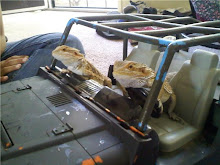
Description
Native to SE Asia, these relatively large (12") geckos are pale gray with bluish spots when they have been in the dark, darkening to dark gray with reddish spots in the light. Like most geckos, tokays are oviparous insectivores.
Young are 2-3" at hatching. Eggs are laid in rocky crevices or under the eaves of houses. The 2-3 eggs, laid several times a year, are sticky and adhere to surfaces. In captivity, they may be laid on the glass sides of their terraria. Incubation time for the eggs ranges from 2-6 months for the oviparous Gekko species.
Tokays have the specialized lamellae on the pads of their toes which enable them to walk on vertical surfaces, including ceilings. Contrary to popular misconception, these pads are not "sticky" but rather are composed of tiny, microscopic filaments which find equally tiny imperfections in surface - including glass.
Like many lizards, tokays can darken or lighten their ground and spot colors to better blend in with their background.
Personality
Despite the fact that they follow human habitation, finding human dwellings to be great places to find prey, Tokays are the least lovable of the geckos. They are known for their nasty temperament, cheerfully biting the hand that feeds, cleans or otherwise comes into anything resembling close proximity to them. Their bites are powerful--one might say they are the pit bulls of the gecko world...they hang on and let go only when it suits them. Equipped as they are with numerous sharp teeth, the bites can bleed profusely and, even barring subsequent infection, are annoying for days. Note that while I am a strong believer that almost any animal can be habituated to human contact, such contact can be stressful for many species, and geckos as a whole are known for their marked preference to be left alone.
A note on taming...
My tokay actually spent a great deal of his time out, exposed in his tank, during the day. As time permitted, I started working with him to habituate him to being touched and held. He was okay with the touching in the tank, looked rather puzzled when held, and periodically felt compelled to reach around and gnaw on my knuckles...
Some people report that their tokays have become rather tame. Be that as it may, it should not be assumed that they will all become tame, so if you are looking for a gecko you can handle without any problems, get a leopard or fat-tailed gecko rather than a tokay.
Vocalization
Tokays are so named because of their distinctive "TO-kay! Tokay!" rather booming bark. They also emit a trilling sound. I had one escape (thanks to an iguana who dislodged the top of the tokay tank) who ended up in the closet behind the tank. He started barking and trilling around 3 AM which enabled me to locate him (on the wall behind the boxes of software on the top shelf, of course) and place him back in his tank. If he is hungry and I am not fast enough with the food, he will emit a sound somewhere between the trill and the bark.
A note for Vietnam Vets
I occasionally get letters from vets who stumble around trying to figure out how to nicely ask me if I know of a lizard called the "[four-letter word denoting a normal biological activity]-you" lizard. While I am not sure how tokays may have gotten that sobriquet, other than their attitude when bothered by a large, hairy, heavily armed mammal dozens of times its size, this is, indeed, that lizard.
Captive Environment
Tokays can certainly be set up in a properly furnished terrarium...note, however, that they may rarely be seen as they are strictly nocturnal. A woodland setting (orchid bark from a nursery) planted with small potted plants or leafy silk branches provide hiding places and help keep up the humidity. Tank should be at least a 20 gal to allow enough room for the gecko to grow and to be able to properly establish a temperature gradient (75-90/days, 70-80/nights). Being nocturnal, they do not require a UVB-producing fluorescent. If a light bulb is used for night time heating, a non-white light heat source must be used (such as a nocturnal reptile bulb, ceramic heating element, etc.).
Captive Diet
They should be fed daily (crickets [properly gut-loaded for at least 24 hours before feeding out], Zoophobas or, for smaller tokays, mealworms [also gut-loaded]). Larger tokays may take pink mice.
Water
They generally will not drink out of a bowl of water, so one area of a tank wall should be sprayed every day (evening) to furnish water for them to lap up. Another way to boost humidity and provide water for lapping is to place some ice cubes on top of the screened top over the plants...the meltwater drips on the leaves for easy lapping.
Initial Veterinary Care
The majority of the tokays in pet stores are wild caught and, like all wild caught imported reptiles, heavily stressed, usually dehydrated, often emaciated, and always parasitized. Take a fresh fecal to a reptile veterinarian for a fecal flotation to determine if the animal is infected with worms; if so, treatment is required (generally, oral medication administered 2-3 times over a period of 2-3, or 4-6 weeks).
Boa.jpg)



No comments:
Post a Comment